Canada's major GHG emitters -- it's not getting better
 Ottawa, Canada (GLOBE-Net) – The total amount of Greenhouse gas emissions from Canada’s largest emitters in 2005 was virtually unchanged over 2004 figures according to a new report from Statistics Canada and Environment Canada. The data shows less than half a percentage point change in emissions from year to year for all reporting facilities and for comparable facilities that filed returns in both years. The problem is not getting worse for this group, but overall it is not getting any better either.
Ottawa, Canada (GLOBE-Net) – The total amount of Greenhouse gas emissions from Canada’s largest emitters in 2005 was virtually unchanged over 2004 figures according to a new report from Statistics Canada and Environment Canada. The data shows less than half a percentage point change in emissions from year to year for all reporting facilities and for comparable facilities that filed returns in both years. The problem is not getting worse for this group, but overall it is not getting any better either.
Many of the largest emitters come from familiar sources, such as coal-fired power generation and the oil sands industry. The data also shows that while large industrial facilities are significant sources of greenhouse gas (GHG) emissions, all sectors of the economy contribute to the problem.
The latest figures released by Environment Canada cover facilities that emit more than 100,000 tonnes of carbon dioxide equivalent (CO2e) each year. By law they are required to report their annual releases.
For the 2005 calendar year, a total of 336 facilities reported a cumulative GHG output of 280 metric tonnes of CO2 equivalents (Mt CO2e). This represents approximately 37% of Canada’s total GHG emissions, though comprehensive figures for 2005 have yet to be released. Twenty-six facilities fell below the reporting threshold but submitted their emissions voluntarily.
The majority of emissions from large facilities (93%) were carbon dioxide, while methane accounted for 3%, and nitrous oxide just over 2%. Other greenhouse gases - hydrofluorocarbons (HFCs), perfluorocarbons (PFCs), and sulphur hexafluoride (SF6) - accounted for the remaining 2% and originated primarily from the manufacturing sector.
On a regional basis, facilities in Alberta and Ontario accounted for the largest shares of reported emissions, accounting for 39% and 28% of total emissions, respectively. The next largest contributors were Saskatchewan and Quebec, at around 8% each.
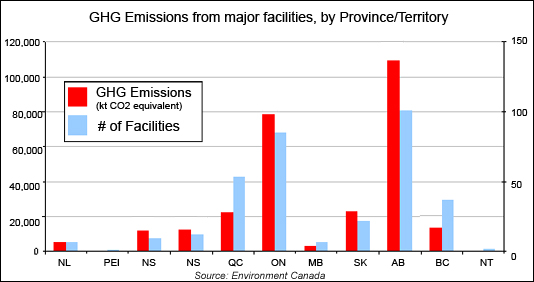
In terms of year-over-year comparisons, British Columbia and Quebec led the country in percentage declines in emissions from large facilities, while Manitoba showed the largest year-over-year increase. These observations are based on an analysis done for GLOBE-Net by Acton White Associates Inc.
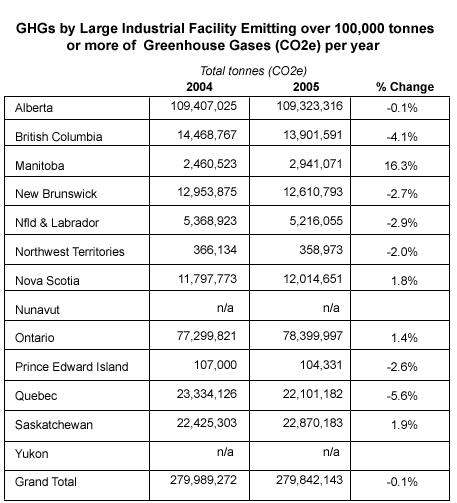
Coal-fired utilities and fossil fuel refineries dominated the top of the large emitter list, with the steel industry, aluminum production, cement plants, natural gas pipelines, and other sectors also represented. While oil sands refineries were among the top individual emitters, the small number of such facilities means that the sector’s overall emissions are overshadowed by those from energy utilities and the manufacturing sector.
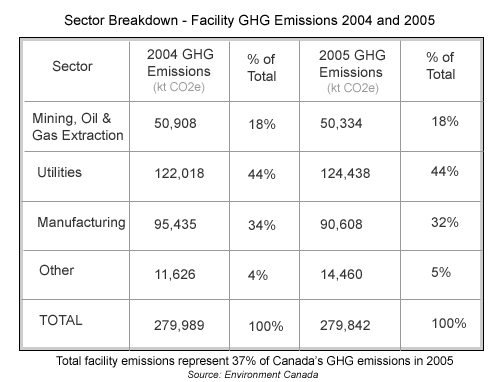
Coal and oil-fired electricity generation accounted for most facilities’ emissions. On a national level, energy utilities contribute around 16% of Canada’s total GHG emissions.
Manufacturing facilities also contribute significantly – nearly one-third of all reported facility emissions and approximately 12% of the national total.
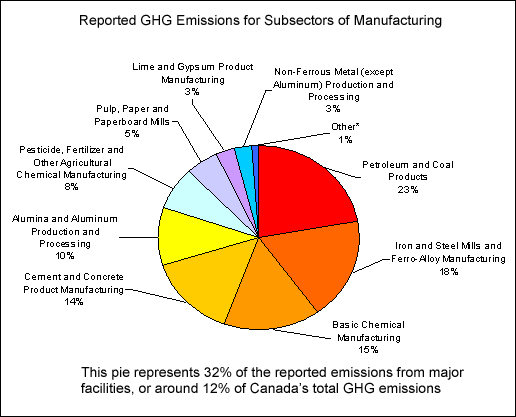
An online summary of facility GHG emissions with a searchable database is available here.
Large emitters in context
Single ‘point’ sources of greenhouse gas emissions, such as the above noted facilities, are easily identifiable, and can be targeted for efficiency initiatives or technology investments. Pollution control devices, advanced technologies such as carbon capture and sequestration, and even simply replacing fossil fuel facilities with cleaner sources are options which can potentially be used to reduce emissions.
All of the reporting facilities will likely be affected by upcoming federal climate change legislation. Reports indicate that intensity-based targets, measured as emissions per unit out output, will be established for the major emitting sectors, with options to contribute to a clean technology fund, offset emissions with other projects, or participate in emissions credit trading.
There is some concern with intensity targets, however, as they do allow overall emissions to grow. For example, the United States’ government has pursued an emissions intensity strategy, and acknowledged this week that total emissions will be 11 percent higher in 2012 than they were in 2002, and 19 percent higher than 2000 levels by 2020. With a surging oil industry and demand for primary resources such as metals on the rise, Canada’s own GHG profile would likely continue to rise with an intensity-based program.
The federal government’s plan, however, includes a transition to a hard-cap system in the future, which in our view is an appropriate way to curb emissions and also send a clear message to spur investment now. With achievable intensity targets in the short-term, and the certainty of a cap in the future, businesses are likely to take the necessary steps to ensure that their new capital investments lead towards cleaner operations.
An important fact to note is that the 336 largest GHG emitters in Canada account for less than 40% of total national emissions. Significant contributions are made by transportation, residential energy use, agriculture, and other sources.
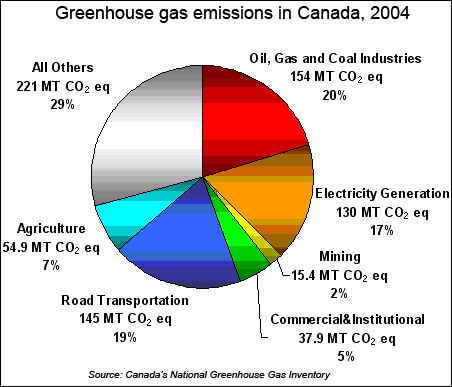
This means that in addition to large industries and utilities, other sectors of Canadian society will be required to reduce GHG emissions if the country is to achieve the desired cuts. A comprehensive plan will include measures in all of these areas.
While it is easy to focus on greenhouse gas emissions coming from plants and smokestacks that are associated with industry, the truth is that these emissions are tied to our everyday lives. Coal-fired utilities exist to power our computers, light bulbs, and refrigerators; the oil industry provides the necessary fuel to sustain our cars and trucks; metal refineries provide materials which everyone consumes.
In order to ensure that any legislation aimed at large emitters is effective, support measures must also be included. Renewable energy should be encouraged, and in some cases incentives developed equal to or greater than those awarded to fossil fuels in the past. Energy efficiency is vital, and can be greatly improved through building codes and standards for appliances that place energy as a top priority.
Research has shown that improving efficiency and shifting towards cleaner technologies can improve the economy, creating new industries and spurring innovation while reducing GHG emissions. As many studies have indicated, notably the Stern Review, it is more than possible to ‘be green and grow’, and Canada is well positioned with a variety of natural capital and human resources to take advantage of the transition to a cleaner economy.
The recently released report by the GLOBE Foundation on the Endless Energy Model lays out a roadmap for achieving significant reductions in GHG emissions while transitioning to a cleaner economy.
The Endless Energy Model not only clarifies uncertainties about the future of the energy economy, it sets out a practical guide to achieving energy self-sufficiency through market driven conservation and cleaner, greener energy sources without diminishing quality of life. The net effect is low-to-no emissions and a truly sustainable energy economy for generations to come.
More details on the Endless Energy model are available here.
You can return to the main Market News page, or press the Back button on your browser.

